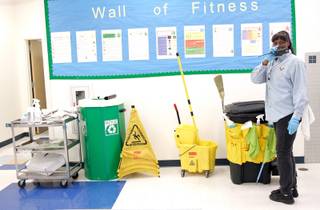Saturday, Nov. 14, 2009 | 2 a.m.

Education Secretary Arne Duncan talks about education reform during a speech at the National Press Club in Washington on May 29. Duncan plans to give $4.35 billion to states that use the most innovation in the first round of stimulus spending, and officials here are concerned that Nevada will miss out because of its conservative spending.
Sun Coverage
It’s official: Nevada has been shut out of the “Race to the Top,” a federal grant program offering $4.35 billion to improve the nation’s public schools.
Keith Rheault, Nevada’s superintendent of public instruction, said Thursday “it’s looking pretty hopeless ... they won’t even let us come to the starting line.”
To compete for the grants, states must, among other qualifying criteria, allow the use of student test scores in the evaluation of their teachers. During a special legislative session in 2003, Nevada lawmakers passed a last-minute bill that explicitly prohibited using test data in teacher evaluations.
In a telephone conference call with reporters Thursday to discuss the program, U.S. Education Secretary Arne Duncan said he’s waiting to hear from Nevada’s attorney general as to the Silver State’s eligibility. If the statute were to be changed during a special legislative session, Nevada might qualify for a second round of grant awards.
But as far as the first — and largest — batch of grants go, Duncan said it’s no longer a question of “who’s eligible, but who’s going to win.”
There is good news: Nevada could still win millions of dollars from another federal program to help turn around its worst-performing schools, and $650 million is available for school districts that team up with outside organizations on innovative initiatives. Rheault said his staff is working on those applications.
Like Nevada, California didn’t allow test scores to be used in teacher evaluations, but the Golden State’s Legislature voted last month to change the law to qualify for the “Race to the Top.”
The potential funding is determined by the size of the state’s student population: California, Texas, New York and Florida are each eligible for $350 million to $700 million. Nevada would have been eligible for $60 million to $175 million, based on the U.S. Education Department’s projections for the first round of grant awards.
• • •
The news Wednesday that budget cuts and layoffs had nearly tripled the size of the backlog of work orders for the Clark County School District’s maintenance department prompted Sun readers to offer suggestions.
Among them: Why doesn’t the School District ask for volunteer help from the construction industry that profited so richly from building campuses during the boom years? (To be sure, campuses have benefited over the years from the largesse of homebuilders and contractors, who have helped with repainting exteriors, installing landscaping and other beautification projects.)
Others wondered whether the district should retain an efficiency expert to make sure it was following best practices.
In fact, the facilities division — which oversees the maintenance department — is trying new approaches to boost efficiency, including creating small teams of workers to be responsible for a set group of schools in particular geographic areas. The long-term goal is to have four service areas, each with its own warehouse, within the next 10 years.
In the meantime, maintenance workers are assigned laptops and cell phones to better track work orders and cut down on the paperwork for the central office.
• • •
While other schools bemoan custodial cutbacks, Spring Valley High School Principal Bob Gerye is adjusting to the loss of block scheduling, which the district eliminated to save $11 million.
Because students are now limited to the traditional schedule of six classes, instead of a rotating block of eight that left more room for electives, Gerye had to give up 18 teachers.
“I’d clean the school myself if we could have block scheduling back,” Gerye said. “And you can quote me on that.”


Join the Discussion:
Check this out for a full explanation of our conversion to the LiveFyre commenting system and instructions on how to sign up for an account.
Full comments policy